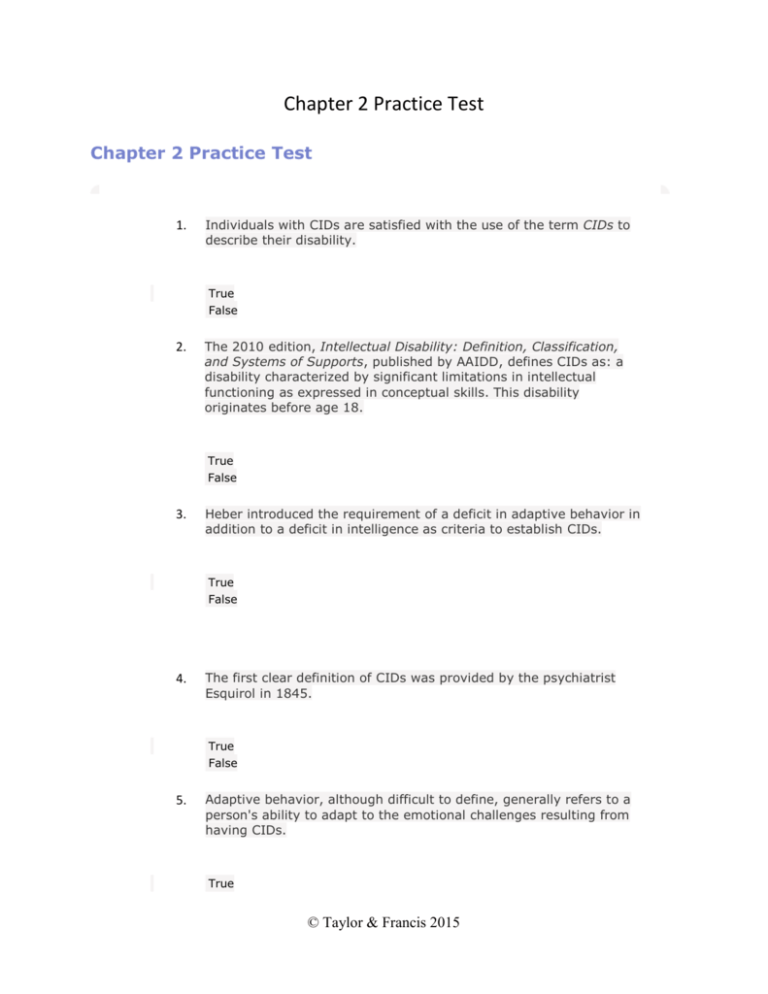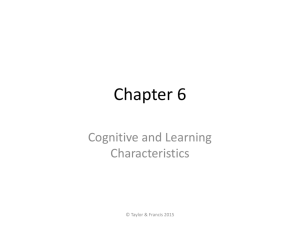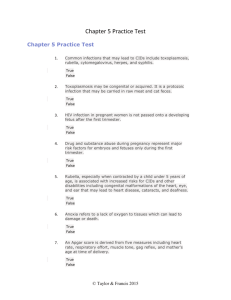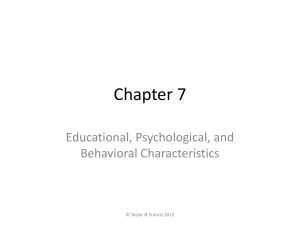Chapter 2 Practice Test
advertisement

Chapter 2 Practice Test Chapter 2 Practice Test 1. Individuals with CIDs are satisfied with the use of the term CIDs to describe their disability. True False 2. The 2010 edition, Intellectual Disability: Definition, Classification, and Systems of Supports, published by AAIDD, defines CIDs as: a disability characterized by significant limitations in intellectual functioning as expressed in conceptual skills. This disability originates before age 18. True False 3. Heber introduced the requirement of a deficit in adaptive behavior in addition to a deficit in intelligence as criteria to establish CIDs. True False 4. The first clear definition of CIDs was provided by the psychiatrist Esquirol in 1845. True False 5. Adaptive behavior, although difficult to define, generally refers to a person's ability to adapt to the emotional challenges resulting from having CIDs. True © Taylor & Francis 2015 False 6. Perhaps the greatest influence on the area of adaptive behavior testing was made by Alfred Binet. He was asked (along with Theodore Simon) by the Ministry of Education in France to develop a test that would differentiate individuals with and without CIDs based on adaptive behavior. True False 7. The Wechsler Scales provide an IQ with a mean of 100 and a standard deviation of 15 (the Stanford-Binet-V also has a mean of 100 and a standard deviation of 15). True False 8. On the Wechsler Scales, approximately 85% of the population will score between the mean and + one standard deviation from the mean. True False 9. Classification on the basis of needed supports requires classifying individuals with CIDs in a way that will suggest the type and extent of financial support specifically that they will need to perform optimally in their environment. True False 10. The Larry P. v. Riles court case brought attention to the fact that African-American children were grossly overrepresented in classes for mild CIDs. True False © Taylor & Francis 2015 11. The prevalence rate for CIDs increased during the 1970s and 1980s. One reason for this occurrence can again be explained by the increase of drug and alcohol usage. True False 12. Three important processes when characterizing CIDs are _______, _______, and ________. naming, defining, and classifying. SPMR, TMR, and EMR. adaptive behavior, IQ, and social skills. chronological age, developmental age, and social age. 13. CIDs has been classified by etiology, mental ability (IQ), educational needs, and more recently, by _______. levels of needed supports. levels of functional independence. levels of adaptive behavior. levels of social adaptability. 14. The number of individuals with CIDs is generally reported to be about 1% of the population but varies based on age, geographic region, ______, and ______. number of siblings with CIDs and age of parents. socioeconomic status and ethnic background. age of parents and religion and ethnicity. prenatal care and age of father. 15. In 1973 a significant change in the criteria for determining CIDs was recommended. After considerable debate, the decision was made to _____. © Taylor & Francis 2015 include Social Skills Adaptability Scales (SSAS) and Social Skills Functioning Scales (SSFS). eliminate the use of IQ and focus on adaptive behavior. lower the IQ cutoff from one SD below average to two SDs below average. change criteria to closely reflect criteria for learning disabilities (LD). 16. The 1992 AAMR Manual recommended elimination of the levels of CIDs based on IQ and replace them with levels of needed supports. The four levels of support included _______, _________, _______, and _________. intermittent, limited, extensive, and pervasive. occasional, frequent, intensive, and constant. legal, financial, social, and functional. academic, social, adaptive behavior, and psychological. 17. The number of individuals with CIDs is generally reported to be around _____ of the population. .05% 5% 10% 1% 18. The Larry P. v. Riles court case brought attention to the fact that ________ children were grossly overrepresented in classes for mild CIDs. Puerto Rican inner-city African-American male 19. The number of students with CIDs ages 6-21 served under IDEA was 603,331 in 1997-1998 and _______ in 2001-2002. © Taylor & Francis 2015 605,268 803,269 300,256 200,268 20. Consider the various classification systems used for individuals with CIDs throughout recent history. Describe each system and provide pros and cons for each. 21. Some people felt that the label mental retardation resulted in lower teacher expectations and poor self-concept for the person being labeled (e.g., Algozzine & Sutherland, 1977; Jacobs, 1978; Taylor, Smiley, & Ziegler, 1983). Briefly design a hypothetical study (include statement of the problem, research question(s), and methodology) to address teacher expectations based on the MR label. © Taylor & Francis 2015












